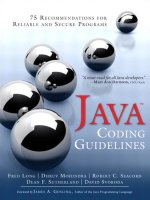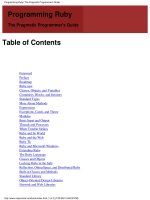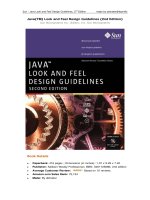Addison wesley java and JMX building manageable systems jan 2003 ISBN 0672324083
Bạn đang xem bản rút gọn của tài liệu. Xem và tải ngay bản đầy đủ của tài liệu tại đây (4.28 MB, 986 trang )
•
TableofContents
•
Index
Java™andJMX:BuildingManageableSystems
ByHeatherKreger,WardHarold,LeighWilliamson
Publisher
:AddisonWesley
PubDate
:December30,2002
ISBN
:0-672-32408-3
Pages
:592
Javaisnowusedwithincreasingfrequencytodevelopmission-critical
applications.UsingJavaManagementExtensions(JMX)isthekeyto
managingthoseapplications.AsJMXisincreasinglyacceptedintothe
fieldsofembeddedsystems,enterprisesystems,andtelephony,itis
clearthatallJavadeveloperswillencounterJMXbeforelong.
Java(TM)andJMX:BuildingManageableSystemsisthedefinitiveguide
toJMX,combininganintroductiontothetechnologywithextensive
coveragethatwillmakethisbookafavoritereference.Muchmorethan
justanexplanationoftheJMXspecifications,thisbookcandrastically
reduceareader'sJMXlearningcurvebyexplaininghowtodevelop
managementrequirementsandapplyJMXtothem.Thebook'scoverage
includes:
AmanagementprimerforJavaprogrammersandarchitects
AhistoricalperspectiveontheevolutionofJMXanditsrelationto
othermanagementstandards,includingSNMP,CIM/WBEM,
TMN,andCMIP
DevelopmentofJMXManageableResourceswithStandardand
DynamicMBeans
DevelopmentwithModelMBeansascustomizablegeneric
instrumentationusingboththeJMXAPIsandXMLfiles
MBeanServer,includingtheMBeanregistryandobjectnaming
scheme,thegenericMBeaninterface,andthequerymechanism
JMXMonitorsandNotifications
MBeanServerServicesincludingthetimer,relationship,and
dynamicloading,alongwithcustomservicesforXMLservices,
HTTPadapters,RMIconnectors,andsecurityexposuresand
permissions
JMXbestpractices,includingdeploymentpatterns,
instrumentationpatterns,federationpatterns,andbestpractices
JMXintegrationintoJ2EEandtheJSR077managementmodels
inJ2EE1.4
UsingJMXtomanageWebservicesfromtheperspectiveof
serviceproviders,registryproviders,andusers
Writtenwithanunparalleleddegreeofin-the-trenchesfamiliarityandfull
ofpracticalexamplesandworkingsamplecode,Java(TM)andJMXisa
must-haveintroduction,technologicalguide,andreferenceforJava
architectsanddevelopers.
•
TableofContents
•
Index
Java™andJMX:BuildingManageableSystems
By
HeatherKreger,WardHarold,LeighWilliamson
Publisher
:AddisonWesley
PubDate
:December30,2002
ISBN
:0-672-32408-3
Pages
:592
Copyright
Preface
Introduction
ThisBook'sIntendedAudience
WhatYouNeedtoKnowbeforeReadingThisBook
WhatYouWillLearnfromReadingThisBook
SoftwareNeededtoCompletetheExamples
HowThisBookIsOrganized
WheretoDownloadtheAssociatedCodeforThisBook
ConventionsUsedinThisBook
AbouttheCover
Acknowledgments
PartI.
JMXIntroduction
Chapter1.
ManagementConcepts
Section1.1.
ProgressofManagement
Section1.2.
ManagementArchitectures
Section1.3.
ManagementTechnologies
Section1.4.
ManagingtheLifecycle
Section1.5.
ManagementDisciplines
Section1.6.
ManagedResourceResponsibilities
Section1.7.
ManagementPatterns
Section1.8.
ManagementApplications
Section1.9.
Summary
Section1.10.
GeneralReferences
Notes
Chapter2.
IntroductiontoJMX[1]
Section2.1.
WhyWeNeedJMX
Section2.2.
WhichApplicationsShouldBeManageable?
Section2.3.
TheGoalsofJMX
Section2.4.
History
Section2.5.
JMXOverview
Section2.6.
QuickTourofJMX
Section2.7.
Summary
Notes
PartII.
JMXDetails
Chapter3.
AllaboutMBeans
Section3.1.
MBeanFundamentals
Section3.2.
MBeanConstruction
Section3.3.
DesignGuidelines
Section3.4.
Summary
Chapter4.
ModelMBeans
Section4.1.
Introduction
Section4.2.
TheModelMBeanInterface
Section4.3.
ManagedResources
Section4.4.
ModelMBeanInfo
Section4.5.
Descriptors
Section4.6.
BehavioroftheModelMBean
Section4.7.
XMLService:PrimingModelMBeanInfofromXMLFiles
Section4.8.
UsingModelMBeans
Section4.9.
CommonMistakeswithModelMBeans
Section4.10.
Caveats
Section4.11.
Summary
Section4.12.
XMLFileExample
Notes
Chapter5.
TheMBeanServer
Section5.1.
TheMBeanServerFactoryClass
Section5.2.
ObjectNaming
Section5.3.
TheMBeanServerInterface
Section5.4.
TheMBeanServerDelegateMBean
Section5.5.
FindingMBeans
Section5.6.
Notifications
Section5.7.
Summary
Chapter6.
MonitorsandMonitoring
Section6.1.
TheJMXMonitorService
Section6.2.
ConcreteMonitors
Section6.3.
Summary
Chapter7.
JMXAgentServices
Section7.1.
TimerService
Section7.2.
DynamicMBeanLoadingService
Section7.3.
RelationService
Section7.4.
JMXConnectors
Section7.5.
Summary
Chapter8.
SecuringJMX
Section8.1.
JMXSecurityExposures
Section8.2.
Permission-BasedSecurityFundamentals
Section8.3.
JMXPermissions
Section8.4.
UsingJMXSecurity
Section8.5.
Summary
Chapter9.
DesigningwithJMX
Section9.1.
MBeanServerDeploymentPatterns
Section9.2.
InstrumentationPatterns
Section9.3.
MBeanRegistrationandLifecycle
Section9.4.
BestPractices
Section9.5.
Summary
PartIII.
ApplicationofJMX
Chapter10.
J2EEandJMX
Section10.1.
Java2EnterpriseEdition
Section10.2.
J2EEManagement
Section10.3.
ManagementToolAccess:TheMEJB
Section10.4.
J2EEManagementModels
Section10.5.
StandardManagementFunctions
Section10.6.
Application-SpecificExtensions
Section10.7.
AreasMissingfromJ2EEManagement
Section10.8.
TheVision
Section10.9.
SampleJSR77Code
Section10.10.
Summary
Notes
Chapter11.
WebServicesandJMX
Section11.1.
WebServicesOverview
Section11.2.
WebServiceRegistryManagement
Section11.3.
WebServiceExecutionEnvironmentManagement
Section11.4.
WebServiceManagement
Section11.5.
Summary
Section11.6.
CodeListings
Notes
AppendixJMXinProducts
SectionA.1.
JMXAgentImplementations
SectionA.2.
JMXManagers
SectionA.3.
JMX-EnabledProducts
Notes
Index
Copyright
Manyofthedesignationsusedbymanufacturersandsellersto
distinguishtheirproductsareclaimedastrademarks.Wherethose
designationsappearinthisbook,andAddison-Wesleywasawareofa
trademarkclaim,thedesignationshavebeenprintedwithinitialcapital
lettersorinallcapitals.
Theauthorsandpublisherhavetakencareinthepreparationofthis
book,butmakenoexpressedorimpliedwarrantyofanykindand
assumenoresponsibilityforerrorsoromissions.Noliabilityisassumed
forincidentalorconsequentialdamagesinconnectionwithorarisingout
oftheuseoftheinformationorprogramscontainedherein.
Thepublisheroffersdiscountsonthisbookwhenorderedinquantityfor
bulkpurchasesandspecialsales.Formoreinformation,pleasecontact:
U.S.CorporateandGovernmentSales(800)382-3419
ForsalesoutsideoftheU.S.,pleasecontact:InternationalSales
(317)581-3793
VisitAddison-WesleyontheWeb:www.awprofessional.com
LibraryofCongressCataloging-in-PublicationDataKreger,Heather.
JavaandJMX:buildingmanageablesystems/HeatherKreger,Ward
Harold,LeighWilliamson.
p.cm.
ISBN0-672-32408-3(Paperback:alk.paper)1.Java(Computer
programlanguage)2.Computersoftware--Development--Management.I.
Harold,Ward.II.Williamson,Leigh.III.Title.
QA76.73.J38K742003
005.13'3--dc212002014486
Copyright©2003byPearsonEducation,Inc.
Allrightsreserved.Nopartofthispublicationmaybereproduced,stored
inaretrievalsystem,ortransmitted,inanyform,orbyanymeans,
electronic,mechanical,photocopying,recording,orotherwise,withoutthe
priorconsentofthepublisher.PrintedintheUnitedStatesofAmerica.
PublishedsimultaneouslyinCanada.
Forinformationonobtainingpermissionforuseofmaterialfromthis
work,pleasesubmitawrittenrequestto:PearsonEducation,Inc.
RightsandContractsDepartment75ArlingtonStreet,Suite300
Boston,MA02116
Fax:(617)848-7047
Textprintedonrecycledpaper12345678910—CRS—0605040302
Firstprinting,December2002
Dedication
Dedicatedtomyhusband,Ken,
andmydaughters,JenniferandJessica,
forthesacrificestheymadesothat
IcoulddosomethingIjusthadtodo.
H.K.
Thisone,thefirst,isformyparents,
CloyceandJuneHarold.
Thanksforeverything,MomandDad.
W.H.
Dedicatedtomyfamily,whosesupport
andpatienceisboundless.
L.W.
Preface
Introduction
ThisBook'sIntendedAudience
WhatYouNeedtoKnowbeforeReadingThisBook
WhatYouWillLearnfromReadingThisBook
SoftwareNeededtoCompletetheExamples
HowThisBookIsOrganized
WheretoDownloadtheAssociatedCodeforThisBook
ConventionsUsedinThisBook
AbouttheCover
Acknowledgments
Introduction
Welcome!Youhavejustopenedyourkeytothesecretartof
management.Thisbookisyourcomprehensiveguidetothedevelopment
ofmanageableapplicationsoftwareusingtheJavaManagement
Extensions(JMX).NowthatJavahasmadetheleapfromcooltocritical,
everydeveloperwhohasdeployedamission-criticalapplicationknowsit
isnotenoughjusttowritegreatcode;tobetrulyuseful,critical
applicationsmustbemanageableaswell.WiththepublishingoftheJMX
specificationandtheavailabilityofmultipleJMXimplementations,Java
programmershaveastandardmechanismwithwhichtoinstrumentand
managetheirsoftwareproducts.Thisbookwillprovideyouwiththe
informationnecessarytoleverageJMXtocreateanewgenerationof
better-instrumented,moremanageable,andthereforemorereliable
mission-criticalJavaapplications.
AtthemomentthetwobiggestgrowthareasforJavaareenterpriseand
embeddedsystems.TensofthousandsofITdevelopersarenoworsoon
willbeusingJ2EEtechnologiestocreatemission-criticalbusiness
systems.ThemajorJ2EEvendors,includingIBMWebSphereandBEA
WebLogicapplicationservers,areusingJMXtoprovidetheirown
management,aswellastoenableyours.TheJ2EE1.4standardisbeing
extendedtoincludemanagementinterfacesusingJMXasdefinedby
JSR(JavaSpecificationRequest)77.Attheotherendofthespectrum,
thousandsmoredeveloperswillbeusingJavatocreateembedded
applications,fromset-topboxestoremotepumping-stationmonitors.
Itisessentialthattheseapplications,whichrununattendedon"invisible
computers"forthemostpart,beasself-monitoringandself-managingas
possible.JMXprovidesasubstrateuponwhichtoconstructsuchselfmonitoring/managingapplications,andacopyofthisbookwill
substantiallyreduceyourJMXlearningcurve.
JMXisalsobeingacceptedbythetelephonyindustryasamanagement
infrastructureforJavafortheAdvancedIntelligentNetwork(JAIN).As
thesespecificationsfortheuseofJavaintelephonyservice
environmentsemerge,wholenewindustrieswillneedtobecomefamiliar
withJMX.TheprobabilitythatyouwillencounterJMXinoneformor
another,aspartofyourowndesignsorastheinstrumentation
mechanismforcomponentsofyourinfrastructure,isveryhigh.Thisbook
willgiveyouthefoundationandtechnicaldetailsyouneedtomake
effectiveuseofJMXwhereveryoufindit.
AlthoughitiswellknownthatJMXiscontinuingtoevolve,itsbasic
architectureandinterfaceswillremainconsistent.Thereismoretousing
JMXthanunderstandingthearchitectureandinterfaces;youalsoneedto
understandhowitconnectstomanagementsystems,theroleitplaysin
themanagementindustry,appropriateuseofthetechnology,and
managementdesignpatterns.Inshort,youneedtounderstandhowto
createamanageablesystem.
Thisbookhasbeenwritteninacomprehensivemannerbyexpertsinthat
space.Italsowillgiveyouanin-depthunderstandingoftheapplicationof
JMXinhottechnologies:J2EEandWebservices.Youwillfindthisbook
tobeusefullongafternewversionsofJMXbecomeavailablebecause
theconceptsintroducedhereareclassicapplicationsofmanagement
conceptsandtechnologiestotheJavafamily.Thisbookwilldomore
thanhelpyouwriteMBeans;itwillhelpguideyoubuildmanageable
systems.
ThisBook'sIntendedAudience
OurprimarygoalinwritingthisbookistoexplainJava-based
management,manageability(i.e.,enablingresourcestobemanaged),
andJMXindetail,andtomakeiteasytounderstand.
Architectsanddevelopersinvolvedinthedesignandimplementationof
mission-criticalJavaapplicationsaretheprimaryaudienceforthisbook.
Theyunderstandthattheirbiggestchallengescomewellafterthefirst
successfulinstallationofanewpieceofsoftware,whentheirclient's
businessbecomescriticallydependentonthatsoftware.Thenitis
essentialthatadministratorsbeabletomonitorandmanagethe
applicationdayandnighttokeepthebusinessinbusiness.Untilrecently,
eachJava-basedproducthadtodevelopitsownadhocmanagement
solution.ThatchangedwithpublicationoftheJavaManagement
ExtensionsInstrumentationandAgentSpecification,v1.0.
ThisbookhasbeenwrittenespeciallyforJavadeveloperswhofind
themselvesinasituationwheretheymustenabletheirapplicationtobe
managedbyan"outside"managementsystem.OtherJavadevelopers
andarchitectswhowillfindthisbookusefulinclude
Thosewhoaregoingtohelpcreateanewadministrativeor
managementsystemfortheirJavaapplication
ThosewhoneedtointegratetheirapplicationintoanexistingJMXbasedadministrativeormanagementsystem
Thosewhowanttodevelopsomemanagementfunctionstointeract
withanapplicationthatsupportsJMX
CuriousfolkswhojustliketoknowwhatalltheJavaacronymsstand
for
Thisbookassumesthatyoudonothaveabackgroundinsystemsor
applicationsmanagementandprovidesacomprehensiveoverviewofthe
historyofthemanagementindustryandtheforcesthatcombinedto
makeJMXtheubiquitousmanagementtechnologyforJavaresources
acrosstheJavacommunity.Javaresourcesdeployedinthemicro,
standard,andenterpriseeditionsoftheJDKcanalluseJMX.
TheauthorshaveextensivefirsthandexperiencewithJMXfromnearly
everyangle.HeatherKregerwasanoriginalmemberoftheJMXExpert
Groupandpersonallycontributedthespecification,reference
implementation(RI),andTechnologyCompatibilityKit(TCK)formodel
MBeans.SheisnowinvolvedinWebservicesandapplyingmanagement
tothisemergingspace.WardHaroldisamemberofthecurrentJMX
ExpertGroup(JSR160),theleadarchitectforTivoli'simplementationof
JMXandTMX4J,aswellasTivoli'sWebComponentManagerproduct,
whichusesJMXtomanageresources.LeighWilliamsonwasamember
ofJSR77("J2EEManagement")andthearchitectforWebSphere'sJMX
supportandJSR77support.Thisbookrepresentsourexperiencewith
JMXfromalltheseprojects:Webringyouauniqueinsiderperspective
ontheintent,implementation,application,andevenpitfallsofJMX.Allof
thisJMXexperienceisinthecontextofourextensiveexperienceinall
aspectsofmanagementsystemsandmiddleware.
Thisbookwillbevaluablefordevelopersofapplicationsthatshouldbe
managed,developersofmiddleware,anddevelopersofmanagement
systems.Wehopethatyouwillfinditusefulnotonlyasanintroductionto
JMX,butalsoasafrequentdesktopreferenceasyouconnectyour
applicationtoanexistingmanagementsystemorstarttodevelopyour
ownmanagementapplication.
WhatYouNeedtoKnowbeforeReadingThisBook
Thisbookassumesthatyouarefamiliarwithdevelopingapplications
usingJava.Wedonotassumethatyouhaveexperiencewith
managementsystems.Assuch,thefirstchapterintroducesmanagement
concepts,disciplines,andarchitectures.Ifyouarefamiliarwith
managementsystems,thenyoumayskipthischapterandstartwith
Chapter2(IntroductiontoJMX).
Chapter10(J2EEandJMX)explainsJSR77("J2EEManagement")in
depth,aswellashowitrelatestoJMX.Thischapterassumesthatyou
haveahigh-levelunderstandingofthecomponentsoftheJ2EE
specificationanditsrealizationinJ2EEapplicationservers.
Chapter11(WebServicesandJMX)explainshowJMXcanbeusedto
developmanageableWebserviceapplications.Itwillbehelpfultohavea
generalunderstandingofwhataWebserviceis,andfamiliaritywith
commonWebservicearchitectures.
WhatYouWillLearnfromReadingThisBook
Thisbookwillprovideyouwiththenecessaryinformation,insight,and
examplesforusingJMXtobuildmanageablemission-criticalapplications
orprovideastandardmanagementinterfacetohomegrownandthirdpartymanagementapplications.
ItissometimesasimportanttounderstandthecontextofJava
technologiesasitistounderstandthetechnologyitself.Thisisthecase
withJMX.Therefore,thisbookgivesyoualmosttwochapters(1and2)
detailingthehistoryofmanagementsystems,managementarchitectures,
applications,andtechnologies.Inthesechapterswealsoexplainthe
forcesthatcombinedtomakeJMXsoimportantfortheJavacommunity.
Thisbookgivesyouthebackgroundyouneedtounderstandandenter
intoconversationsinthemanagementindustry.
Specifically,youwilllearntodevelopstandardanddynamicMBeansto
representJMXmanageableresourcesintheirapplications.Youwill
understandhowandwhentousethemodelMBeantorapidlydevelop
extensibleinstrumentationandhowtorepresentinterdependent
managementcomponentsusingtheJMXrelationservice.Because
instrumentationinevitablyrequiresmonitoring,thisbookdiscussesthe
useofJMX'svariousmonitorsanditsnotificationmodelindetail.In
addition,thisbookprovidesworkingsamplecodetoillustratethe
applicationofJMXtechnologyinvarioussettings,includingJ2EEand
Webservices.
SoftwareNeededtoCompletetheExamples
Alloftheexamplesinthisbook,alongwithextrasnotinthebook,canbe
downloadedfromAddison-Wesley'sWebsiteforthisbook:
Ataminimum,youwill
needtohaveaJ2SEJDKandaJMXimplementationinstalledonyour
computertocompileandrunthesamplesshownthroughoutthisbook.
ThesesampleshavebeentestedwiththeTMX4J.Somehavealsobeen
testedwithMX4Jimplementations.TMX4Jis100percentJavacodeand
shouldrunonanyplatform,butithasbeentestedonaWindows
operatingsystem.TMX4JcanbedownloadedforfreefromtheIBM
alphaWorksWebsiteat.
TheexamplesinChapter10demonstratesolutionsbasedonJ2EE
applicationserverproductssuchasWebSphereApplicationServer.The
J2EEserversthatsupportJMXandJSR77arelistedintheappendix.
CompleteproductinformationforWebSphereApplicationServermaybe
foundontheWebat />ToruntheexamplesinChapter11,youwillneedaWebservicesruntime
includingaWebserver,servletengine,SOAPengine,andJMX
implementation.ThesamplesinthischapterweretestedwiththeIBM
WebServicesToolKit,whichisavailableforfreefromtheIBM
alphaWorksWebsiteat.
HowThisBookIsOrganized
Wehavearrangedthecontentofthisbookintothreebroadsections.Part
IintroducesmanagementandJMX.PartIIprovidesdetailedand
comprehensivecoverageoftheJMXarchitecture,APIs,programming
techniques,andpitfalls.Weevenprovideanentirechapterondesign
andimplementationsuggestions,alongwithourfavoritepitfalls.PartIII
laysouttheapplicationofJMXintwofast-growingfields:J2EEandWeb
services.
Werecognizethateachreaderwillbeinterestedindifferentportionsof
thebook,andnoteveryonewillneedtoreadeverychapter.Readerswho
arealreadyfamiliarwithmanagementsystemsmayskipChapter1
(ManagementConcepts),whichintroducesmanagementconcepts,
disciplines,andarchitectures.Weencourageeveryonetoreadatleast
Chapter2(IntroductiontoJMX).Youshouldfeelfreetoreadthose
chaptersthatmostinterestyouoraremostimmediatetoyourneeds.If
youhaveageneralunderstandingofJMX,thentherestofthechapters
ofthebookcanstandalone,soitisnotnecessarytoreadthebook
straightthrough.
Thefollowingisaquicksummaryofthecontentsofeachofthethree
sectionsofthebook:
PartI:JMXIntroduction.Thefirstpartofthebook,Chapters1and
2,introducesyoutothemanagementworldandJMX.JMXisa
managementtechnology,andeffectiveuseofitrequiressome
fundamentalunderstandingoftheaspectsofmanagementand
JMX'sroleineach.Chapter1(ManagementConcepts)describes
thebasicconceptsandvocabularyofsystemandapplications
management.Itstartsbyhighlightingthehistoryofmanagement
technologies,anditexplainsmanagementdisciplines,applications,
architectures,andinformation.Chapter2(IntroductiontoJMX)
describeswhyandhowJMXcameabout,andthenintroduceseach
ofthefundamentalelementsofJMX,MBeans,MBeanServer,and
notifications.Wegiveyouahands-ontourofJMX,usingasimple
serverandtheninstrumentingitformanagementusingJMXto
illustrateeachoftheelements.Ifyouarenewtomanagementand
JMX,werecommendthatyoureadthechaptersinthispartfirstto
providecommonbackgroundmaterialandterminologyforthe
remainderofthebook.
PartII:JMXDetails.PartIIisthemeatofthisbook.Thissection
givesyouthecomprehensivecoverageofJMXalongwithpractical
examplesandadvice,includinghowtorelatesecuritytoJMX.The
managementbeansthatyouwillneedtobeabletoimplementare
introducedwithextensiveexamplesandadviceinChapter3(All
aboutMBeans)andChapter4(ModelMBeans).Chapter5(The
MBeanServer)describestheMBeanServerthatiscentraltoJMX's
agentarchitectureandkeytoitsflexibility.Thischapterdescribesthe
interfacesandservicesthattheMBeanServerprovides:theMBean
registryandobjectnamingscheme,thegenericMBeaninterface,the
querymechanism,andthenotificationsupport.Chapter6(Monitors
andMonitoring)andChapter7(JMXAgentServices)willhelpyou
understandthestandardservicesthatJMXprovidesandhowtouse
them.Chapter8(SecuringJMX)coversacrucialtopicthattheJMX
specificationissilenton.Thischapterdescribesthesecurity
exposurespresentedbythemanagementdomainandoffersa
transparentsecuritylayerbasedontheonedesignedforTMX4J.
Finally,PartIIIcloseswiththepuregoldofChapter9(Designingwith
JMX).Inthischapter,alltheauthorssharetheirexperienceswith
JMXandhowtheseexperiencescanbeusedinrealsystems.
Includedarediscussionsondeploymentmodels,instrumentation
patterns,bestpractices,andpitfalls.
PartIII:ApplicationofJMX.PartIIIiswhereweseeJMX
positionedasafundamentaltechnologyfornewandfast-growing
industries.Chapter10(J2EEandJMX)providesgreatdetail,from
onewhowasthere,abouthowJMX'smanagementofJ2EEsystems
hasbeenstandardizedwithJSR77.Itincludesexamplesofhow
JMXworksinreal-worldapplicationserverproducts.Thesection
endswithalooktothefutureinChapter11(WebServicesand
JMX).ThischaptergivesabriefdescriptionofWebservicesandthe
managementissuesassociatedwiththem.Itthenillustrateshow
JMXcanbeusedtomakeWebservice–basedapplications
manageable.Itlaysouthowtomanagetheregistry,theWebservice
executionenvironment,andtheWebserviceitself.
Appendix.Theappendixprovidesareferenceforimplementersand
usersofJMXtechnology,includinglistsofJMXimplementations,
JMX-enabledmanagementplatforms,andJMX-instrumented
products.
WheretoDownloadtheAssociatedCodeforThisBook
Theassociatedcodefilesdescribedinthisbookareavailableon
Addison-Wesley'sWebsiteat.Toaccess
thesefiles,enterthisbook'sISBN(withoutthehyphens)inthesearch
boxandclickSearch.Whenthebook'stitleisdisplayed,clickthetitleto
gotoapagewhereyoucandownloadthecode.Orgodirectlyto
/>









